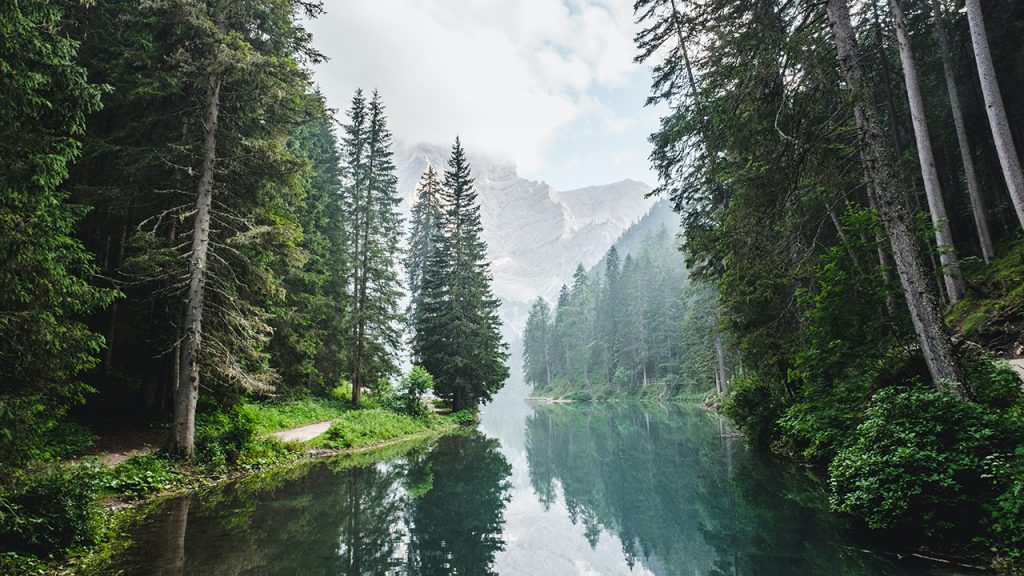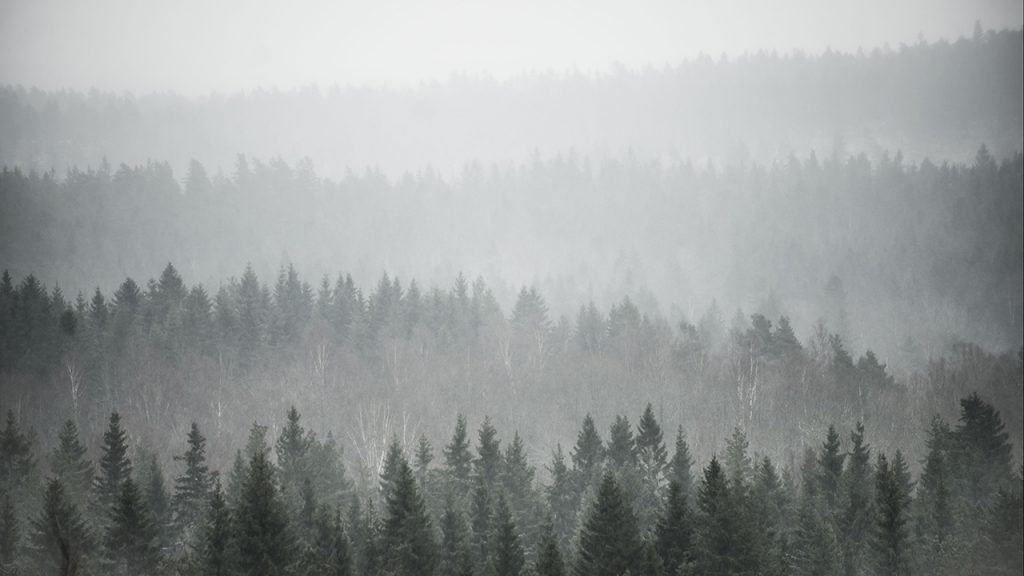
The future of our forests: climate change and trees
From the tropical rainforests in New Guinea to the larch forests of Siberia, trees are a lifeline for Earth. They cleanse the air we breathe, provide a sanctuary for biodiversity, and protect our soil.
Over the last two decades, scientists have also been fast unravelling the complex links between our forests and our climate.
As our climate continues to warm, forests are on the front line of the crisis.
In fact, forest loss is both a cause and effect of climate change. On one hand, these vast and diverse landscapes are threatened by shifting growing seasons and increased risks from droughts, wildfires and invasive species due to climate change.
At the same time, they play a crucial role in driving the climate. Agriculture, forestry and land-use sectors account for around a quarter of greenhouse gas emissions. And, decreasing forest coverage reduces the Earth’s capacity to absorb and store carbon.
At the forefront of climate science, researchers are uncovering the future of Earth’s forests in the face of environmental change using complex computer models.
No longer viewed piece by piece, today’s climate models bring together teams of atmospheric, land, ocean, and ice scientists to build a complete picture of the Earth system, including its forests.
These virtual models require supercomputers the size of tennis courts and take years to develop. A new Earth System Model, known as UKESM1, is the UK’s most advanced tool yet in the race to understand the future of our forests.
This week, as part of National Tree Week, we explore why trees are important for our climate alongside a team of scientists working to improve climate projections for the UK’s environmental science community.
How important are forests for our climate?
The Earth’s surface – of which almost a third is covered by forests – plays a significant role in our weather and our climate.
“Around us, water, carbon, and energy are constantly being exchanged where the atmosphere meets Earth’s surface. These reactions can affect our climate in different ways” explains Dr Chris Jones from the Met Office Hadley Centre.
Forests in particular have far-reaching effects on our climate, not only locally but sometimes hundreds or even thousands of miles away. When trees are included in computer simulations of our climate, scientists have to consider how they might affect rainfall, cloud formation, and global temperature rise.
As you might expect, trees are often associated with rainfall. You can imagine that every tree in a forest acts as a fountain, pulling moisture from the ground and releasing as water vapour through tiny pores, which can form clouds and lead to rainfall.
Forests also act as carbon sinks. They absorb up to a quarter of the carbon dioxide emitted by humans every year by taking carbon out of the air through photosynthesis, and locking it in their wood for decades, or even centuries.
However, forests also can darken the Earth’s surface and decrease the planet’s ability to reflect sunlight – known as its albedo. This means that, in some areas, growing more forests could actually have a warming effect on our climate.
While many push for expanding forest coverage to tackle climate change, there are reasons to be cautious. The complex climate impacts of trees, which are not always acknowledged, underline the importance of Earth System Models that include dynamic ecosystems and vegetation in their climate simulations.
How are forests represented in climate models?
Many of the interactions between forests and our atmosphere are represented in today’s climate models, including the effect they have on Earth’s albedo, and how they exchange water with the atmosphere. The most sophisticated climate simulations even consider how much carbon is absorbed by trees.
“In many climate models, the land is represented based on real observations from today’s surface” says Dr Doug Kelley from the UK Centre for Ecology and Hydrology. It’s a static image of the Earth’s surface, which stays the same when simulating the future climate.
“However, because the land cover stays the same over time, it means that virtual forests are unable to respond to different climate scenarios, and the models miss an important part of the picture” he adds. And that’s where the latest Earth System Models can be incredibly useful for scientists.
To create a clearer image of our future, Earth System Models bring together large teams of scientists who create dynamic representations of vegetation on Earth’s surface. Rather than representing millions of individual plant and tree species, they instead simulate changes in a select number of plant types.
“To use UKESM as an example, we have nine different types of plants, including five different tree types. They are split by leaf type – including broadleaf trees like sycamores, and needleleaves like fir trees.” explains Dr Kelley.
“We look at whether they lose their leaves in winter or dry season, and if they are found in the tropics in colder climates. The different plants types can grow, complete against each other for light and water, and are killed by events like droughts and fires”
This advanced type of computer model even allows researchers to simulate events such as deforestation, and sees farming competing for space with forests in much of the world.

What does the future of our forests look like?
The future of our forests in Earth System Models can vary a lot, depending on the scenarios that scientists are looking at. Many of the impacts from climate change vary based on location, temperature rise, and have to balance the complex relationship between trees and our climate.
As an example, we might compare tropical forests and boreal forests. Tropical forests are under pressure from increased temperatures, changes in rainfall patterns and human disturbances such as deforestation.
Boreal forests, usually found further from the equator, are also threatened by temperature and rainfall changes, as well as increased fire risks. But, as Arctic regions warm, there is some evidence that boreal forest boundaries will start to move northwards, and will expand into new areas of tundra. Tundra are usually defined by a distinct lack of trees, because their growth is currently hindered by low temperatures and short growing seasons.
Although the risks to our forests will clearly increase, we have to look at the impact of climate change on different regions and species to uncover the nuances of the changes ahead, says Dr Jones.
“In some areas, forest loss due to changing climate will cause reduced forest cover, but in others areas, a different climate may facilitate increased forests” he says.
“Another point to consider is that, in both cases, higher CO2 levels will help trees grow and may make them more resilient to climate changes.”
The complex interplay between our trees, our climate and our environment underline the importance of next generation climate models, such as UKESM.
How resilient are forests to climate change?
When we consider how forests will respond to climate change, there are a lot of different variables to consider, according to Dr Chantelle Burton from the Met Office Hadley Centre. This can lead to uncertainty about how resilient different species will be.
Dr Burton says: “We know that higher levels of carbon dioxide levels in our atmosphere can encourage photosynthesis, tree growth and water use efficiency. But, we have to weigh that against higher temperatures, local-scale drought, changes in fire regime, and lower levels of nutrients.”
Researchers use computer models, like UKESM, to see what type of impact future climate change might have on forests. They have become an invaluable tool for looking at tree resilience, and can project changes such as forest distribution under different climate change scenarios.
Dr Burton and Dr Kelley have been exploring whether increased forest fire hazards are likely to have a lasting impact on Earth’s forests. It’s a topic that researchers are keen to know more about given the unprecedented forest fires across the Arctic, Europe and California in recent years. These destructive events show how climate change can lead to sudden, and often dramatic, changes to forest ecosystems.
Trees in savannas, mixed woodland-grassland ecosystems, have evolved to survive or recover from burning. But many of the world’s forests do not typically experience fire, and they are much more vulnerable to warmer temperatures – a small fire event can have a large impact on tree health and wildlife. As a recent example, the Amazon fire in 2019 saw over 900,000 hectares, an area almost half the size of Wales, lost to the flames.
According to recent research by the UKESM team, forest loss may accelerate in future if temperatures rise beyond the Paris Agreement targets. And, if temperatures rise even further, scientists expect around a third of the carbon locked within rainforests to be released, leading to additional heating.
Dr Kelley believes we may already be seeing this type of climate feedback system happening in the Arctic. Over the last year, hundreds of fires have raged through Siberia and Alaska, releasing over 244 million tonnes of carbon dioxide into our atmosphere – for perspective, Britain generates around 350 million tonnes of carbon dioxide in a year.
“In the extreme conditions we’ve seen recently, even some of the most hardy woodland has suffered” says Dr Kelley, cautioning that recovery may not be guaranteed for even robust plant species.
What are the challenges in representing trees in a computer model of climate change?
Trees play a very important role in our climate, so it’s essential that tree cover is accurately represented in computer models. Despite the challenges involved, researchers can recreate forest cover and check the accuracy by comparing their models against real world observations.
“When we’re working on UKESM, we regularly evaluate our forest cover” says Dr Kelley. “Not only do we get forests in the right place, but we also know that removal and release of carbon by trees is very similar to what we see in the real world.”
However, there are some areas where researchers are still making improvements to the models. For example, the complexities of fire are not yet fully represented in Earth System Models, and this will have some impact on how the carbon cycle is simulated. There are already plans to improve how fire is represented when the researchers next update UKESM.
Another challenge arises from the grid-type structure that researchers use to construct climate models. In climate models, the Earth’s surface is divided up into a set of cells – imagine a pixelated view of the earth’s surface – to help simplify the simulation. Within each grid cell – or pixel – entire tree populations behave in the same way. For example, in a single grid cell, all broadleaf evergreen trees will grow together, and shrink together.
This means that a lot of variety you’d find in a real world forest is missing from their virtual counterparts. When you walk around a natural woodland, you’ll see trees at different heights and different ages within the same area. This variety helps to make forests more resilient to change – and might explain why trees in climate models are sometimes slower to recover after disturbances like deforestation, droughts or fire.
Arthur Argles, a doctoral researcher at the University of Exeter, and Professor Peter Cox are starting to introduce the life cycle of trees into models by allowing different plant types to grow over time. The research is still in the early stages, but once complete, it’s possible that computer-simulated forests will start to respond and recover faster, making them more useful for studying the relationships between trees and climate.

Will planting more trees solve climate change?
Planting trees is not the sole solution to climate change, but it can play a part because it will help reduce the level of carbon dioxide that is already in the atmosphere, according to Dr Jones.
“However, the main cause of climate change is burning fossil fuels, and without massive reductions in this activity, climate change will continue” he points out.
Planting trees is a part of a remedial approach to climate change known as nature-based solutions, which could provide over one third of the cost-effective climate mitigation needed by 2030 to stabilise warming within the Paris Agreement targets.
What is UKESM?
The UK Earth System Modelling (UKESM) programme develops and applies the next generation of Earth system models to support research and policy decisions. UKESM is jointly funded by the Natural Environment Research Council and the Met Office. The project team is formed of researchers from the Met Office and eight research centres funded by the Natural Environment Research Council, and is led by the National Centre for Atmospheric Science.
This article received significant input from UKESM researchers: Dr Doug Kelley from the UK Centre for Ecology and Hydrology, and Dr Chantelle Burton and Dr Chris Jones from the Met Office Hadley Centre.
